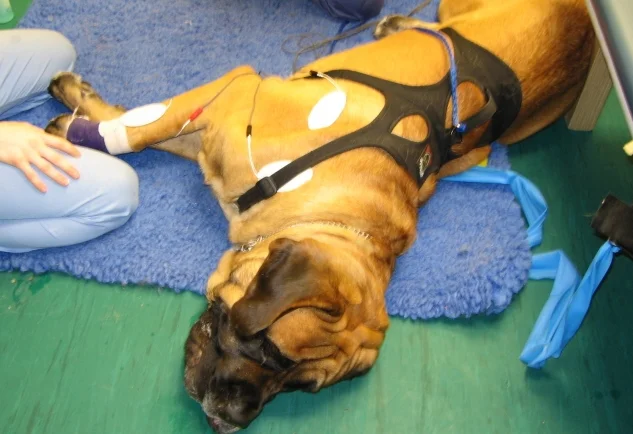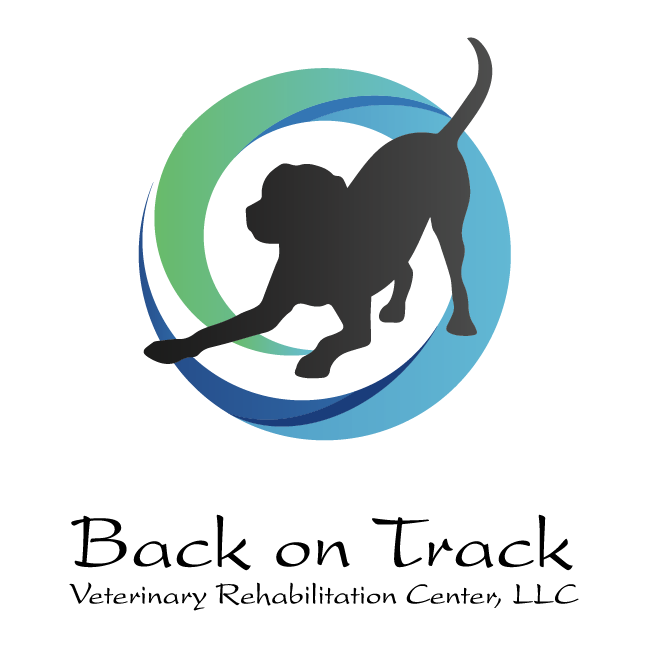Manual Therapy or Bodywork includes a variety of examination and treatment techniques using the hands to explore the areas of dysfunction in muscles, joints, and nerves following injury or degeneration. Manual therapy helps re-establishe more normal movement of the parts of the body that have been limited due to pain. With pain, the body develops persistent unconscious nerve reflexes that inhibit movement and full use of the musculoskeletal system. Many of these manual therapy techniques are derived from human or horse treatments, and are specifically adapted to the dog and cat posture and movement. Muscular and skeletal adjustments and massage techniques improve flexibility, joint health and pain relief.
Our therapists utilize treatments based on direct and indirect joint mobilization, cranial-sacral therapy, proprioceptive neuromuscular facilitation, traditional and Chinese massage (Tui Na) techniques and a variety of other treatments derived from human methodologies. Manual therapy allows the therapist to feel the tone and size of different muscles in a variety of positions, assessing for how the patient is using each muscle or muscle group. Then we assess the range of motion in individual joints, including primary flexion and extension as well as rotation and glides or sideways motion. As we move the joints, we can activate or relax both muscle-tendon units as well as ligamentous stabilizers. Each area is also moderated by nerve reflexes, and neurological protective mechanisms related to pain and control. Manual therapies can relieve the increased muscle tension and spasms related to injury or compensations. We accomplish a lot with very small movements, working gently within each patient's tolerance to overcome movement restrictions and allow more freedom of motion.
LASER Therapy, more correctly referred to as “Low Level Laser Light Therapy”(LLLT) or more recently Photobiomodulation (PBM), is rapidly being assimilated into the treatment regimens used by veterinarians to help pets with a variety of problems. While laser therapy can be used to assist pets and healing from almost any medical condition, it is most commonly employed for dogs with diseases of the soft tissues of the musculoskeletal system (arthritis, sprains and strains, hip dysplasia, shoulder dysplasia, elbow dysplasia, cruciate ligament injuries, etc.) and nervous system (disc disease, lumbosacral disease, and even epilepsy.) Laser can treat the ends and outer surface of the bones, but does not pass into or through bone. The most commonly accepted mechanism of action involves individual cells and light emission. Cells in the body emit and absorb light (bio-photons). These emissions and absorptions of light play key roles in regulating various cellular activities, including energy production, activation of cell division, cell-to-cell communication, cell activation, and cell migration, all of which are essential in wound healing. Optimal results occur when the laser light is of low intensity or “cold laser” meaning that tissue is not heated, as opposed to lasers of higher intensity used for surgery,) only lasts for a short amount of time, and pulses on and off rather than remaining static. The end result of the biological interactions between the laser and the cells is healing and pain relief.
Acupuncture is a fantastic way to improve blood flow to injured tissues, relax tight muscles, reset the pain pathways or gates, and improve neurological function. We employ multiple theories and schools of thought when we perform acupuncture, utilizing the most recent data and neuro-anatomical models. As science develops a better grasp of molecular medicine, the mechanisms of action with acupuncture become more clear. Most animals respond very well to the treatment, and you can see an improvement in specific activities and movements almost right away.
Water Therapy or Hydrotherapy uses the benefits of buoyancy and resistance of hydrostatic pressure to allow a low-impact, targeted workout. With the underwater treadmill, your pet walks into clear Plexiglas box, then warm water fills from beneath the floor, allowing for slow acclimation to the water height. We can use treats or toys to distract them, but most pets do very well right off the bat. Once there is enough water to support the animal (and achieve the ideal resistance), we start the treadmill floor and monitor the gait and comfort level of each patient. Sometimes they need guidance and will have 1 or 2 people in the water as well. Our goal is to develop stamina and strength in order to perform a good, 20-minute session. This may take several months, and some pets will always be limited due to the extent of their disability. We work within the pet's comfort zone and only ask for what they can do well.
Pulsed Electromagnetic Therapy (pEMF) is beneficial to scar tissue remodeling and pain relief. It can work on and through bone, unlike most LASER or electrical therapies. We use two methods - the Assisi Loop and Pulsed Signal Therapy (PST). The science behind pEMF therapies has been well studied, and is also utilized in human medicine: the Ca/CaM anti-inflammatory cascade is well-described. The initial binding of four calcium ions to calmodulin produces a conformational change in CaM, which, in turn, then binds to the constitutive nitric oxide syntheses (both endothelial – eNOS and neuronal - nNOS), which virtually immediately (within seconds) leads to the production of nitric oxide (NO), a principal anti-inflammatory molecule. Nitrous oxide reduces pain, improves blood flow, and reduces edema. It further triggers downstream effects, including the production of cGMP, the ‘energy’ molecule that then drives growth factor production, which, in turn, supports new blood vessel formation, tissue regeneration and then, ultimately, to tissue remodeling. (Assisi site)
Neuromuscular Stimulation (TENS, NMES, IFC) is another adjunct to pain control and muscle maintenance. A Transcutaneous Electrical Nerve Stimulator is primarily used for managing chronic pain. It utilizes biphasic electrical current delivered through electrodes placed on the surface of the skin to stimulate the sensory nerves to block pain signals and help the body's endorphin production (its natural analgesic). TENS can be used daily or on an as-needed basis. Primarily used for preventing disuse atrophy (muscle wasting), NMES is stronger than a TENS unit with a wider pulse width to elicit muscle contraction for a period of time. More than just nerve stimulation, muscles are contracted and relaxed on and off to strengthen muscles, increase blood circulation to the area, and/or to reduce edema. (Medi-stim, INC.)
Therapeutic Ultrasound can be used to relieve swelling, inflammation, and pain, as well as to increase range of motion, reduce muscle spasms and to speed in the healing process of many common injuries. This modality can be used with or without heat to break down excessive scar tissue or calcification.











